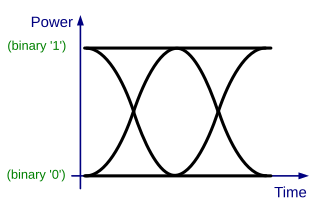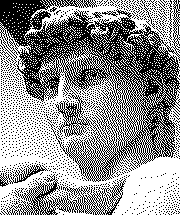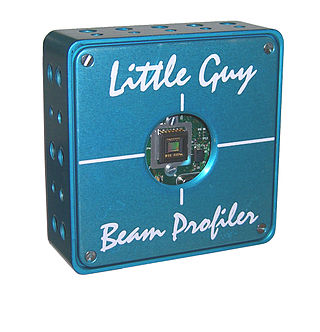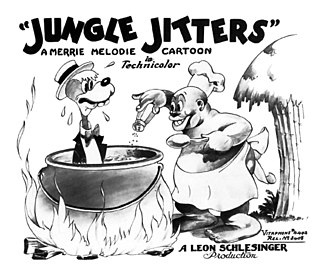
In electronics, an analog-to-digital converter is a system that converts an analog signal, such as a sound picked up by a microphone or light entering a digital camera, into a digital signal. An ADC may also provide an isolated measurement such as an electronic device that converts an analog input voltage or current to a digital number representing the magnitude of the voltage or current. Typically the digital output is a two's complement binary number that is proportional to the input, but there are other possibilities.

In telecommunication, an eye pattern, also known as an eye diagram, is an oscilloscope display in which a digital signal from a receiver is repetitively sampled and applied to the vertical input (y-axis), while the data rate is used to trigger the horizontal sweep (x-axis). It is so called because, for several types of coding, the pattern looks like a series of eyes between a pair of rails. It is a tool for the evaluation of the combined effects of channel noise, dispersion and intersymbol interference on the performance of a baseband pulse-transmission system. The technique was first used with the WWII SIGSALY secure speech transmission system.
In electronics and telecommunications, jitter is the deviation from true periodicity of a presumably periodic signal, often in relation to a reference clock signal. In clock recovery applications it is called timing jitter. Jitter is a significant, and usually undesired, factor in the design of almost all communications links.
Sound can be recorded and stored and played using either digital or analog techniques. Both techniques introduce errors and distortions in the sound, and these methods can be systematically compared. Musicians and listeners have argued over the superiority of digital versus analog sound recordings. Arguments for analog systems include the absence of fundamental error mechanisms which are present in digital audio systems, including aliasing and associated anti-aliasing filter implementation, jitter and quantization noise. Advocates of digital point to the high levels of performance possible with digital audio, including excellent linearity in the audible band and low levels of noise and distortion.

Cinerama is a widescreen process that originally projected images simultaneously from three synchronized 35mm projectors onto a huge, deeply curved screen, subtending 146-degrees of arc. The trademarked process was marketed by the Cinerama corporation. It was the first of several novel processes introduced during the 1950s when the movie industry was reacting to competition from television. Cinerama was presented to the public as a theatrical event, with reserved seating and printed programs, and audience members often dressed in their best attire for the evening.

Jitterbug is a generalized term used to describe swing dancing. It is often synonymous with the lindy hop dance but might include elements of the jive, east coast swing, collegiate shag, charleston, balboa and other swing dances.

Max, also known as Max/MSP/Jitter, is a visual programming language for music and multimedia developed and maintained by San Francisco-based software company Cycling '74. Over its more than thirty-year history, it has been used by composers, performers, software designers, researchers, and artists to create recordings, performances, and installations.

Dither is an intentionally applied form of noise used to randomize quantization error, preventing large-scale patterns such as color banding in images. Dither is routinely used in processing of both digital audio and video data, and is often one of the last stages of mastering audio to a CD.

Extended Resolution Compact Disc (XRCD) is a mastering and manufacture process patented by JVC for producing Red Book compact discs. It was first introduced in 1995.
In optics, tilt is a deviation in the direction a beam of light propagates.
Meanwhile, Back in Communist Russia… (MBICR) was a post-rock band from Oxford, England.

The Musical of Musicals is a musical by Joanne Bogart and Eric Rockwell. It is structured into five acts, each of which is a short musical parodying the style of an American or British musical theatre composer or composer/lyricist team, all dealing with roughly the same classic melodrama plot: "I can't pay the rent!"

A laser beam profiler captures, displays, and records the spatial intensity profile of a laser beam at a particular plane transverse to the beam propagation path. Since there are many types of lasers — ultraviolet, visible, infrared, continuous wave, pulsed, high-power, low-power — there is an assortment of instrumentation for measuring laser beam profiles. No single laser beam profiler can handle every power level, pulse duration, repetition rate, wavelength, and beam size.

Jungle Jitters is a 1938 Warner Bros. Merrie Melodies cartoon directed by Friz Freleng. The short was released on February 19, 1938.

The Jitters were a Canadian rock band formed in Toronto, Ontario in 1981 by Blair Packham, Danny Levy and Matthew Greenberg. Five years of constant performing established them as one of the premier club bands in the Greater Toronto Area.
3-D,3D, or 3d may refer to:
In optics, jitter is used to refer to motion that has high temporal frequency relative to the integration/exposure time. This may result from vibration in an assembly or from the unstable hand of a photographer. Jitter is typically differentiated from smear, which has a lower frequency relative to the integration time. Whereas smear refers to a relatively constant rate during the integration/exposure time, jitter refers to a relatively sinusoidal motion during the integration/exposure time.

Geo Imaging Satellite or GISAT is an Indian imaging satellite class for geostationary orbit with a high temporal resolution, meant for providing near real time imaging with fast revisit capability and real time monitoring. Two satellites will provide resolution in the range of 42 to 318 m. It will carry multi-spectral, multi-resolution imaging instruments.

Jitters was a rock band from Minsk, Belarus, which played mostly rock and post-grunge. The band was formed in 1998 and released the album Split Before, Together Now, as well as several EPs. In 2007, Jitters broke up and its members joined other groups: Konstantin Karman teamed up with Hair Peace Salon, and Ivan Barzenka and Pavel Kudrin joined beZ bileta.












